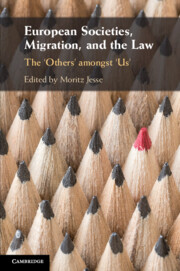Book contents
- European Societies, Migration, and the Law
- European Societies, Migration, and the Law
- Copyright page
- Dedication
- Contents
- Figures and Tables
- Contributors
- Preface
- Acknowledgements
- Abbreviations
- 1 European Societies, Migration, and the Law
- Part I Making the ‘Other’ – The Construction of ‘Otherness’
- Part II The Operation of Legal ‘Othering’ and the National–Foreigner Dichotomy in the EU
- 6 The Rights of ‘Others’ in Domestic Constitutions
- 7 Hierarchies of Privilege
- 8 Alienation of ‘Second Generation Turkish Dutch’ in the Name of ‘Integration’
- 9 Different Levels of ‘Legal Otherness’ in the Context of Expulsion and Entry Bans
- 10 The Non-national as ‘The Other’
- Part III After the Arrival of the ‘Others’ – Reactions to the ‘Refugee Crisis’ of 2015
- Part IV ‘Othering’ in the EU
- Part V European Societies, ‘Otherness’, Migration, and the Law
- Bibliography
- Index
8 - Alienation of ‘Second Generation Turkish Dutch’ in the Name of ‘Integration’
Family Reunification Policies in the Netherlands
from Part II - The Operation of Legal ‘Othering’ and the National–Foreigner Dichotomy in the EU
Published online by Cambridge University Press: 13 November 2020
- European Societies, Migration, and the Law
- European Societies, Migration, and the Law
- Copyright page
- Dedication
- Contents
- Figures and Tables
- Contributors
- Preface
- Acknowledgements
- Abbreviations
- 1 European Societies, Migration, and the Law
- Part I Making the ‘Other’ – The Construction of ‘Otherness’
- Part II The Operation of Legal ‘Othering’ and the National–Foreigner Dichotomy in the EU
- 6 The Rights of ‘Others’ in Domestic Constitutions
- 7 Hierarchies of Privilege
- 8 Alienation of ‘Second Generation Turkish Dutch’ in the Name of ‘Integration’
- 9 Different Levels of ‘Legal Otherness’ in the Context of Expulsion and Entry Bans
- 10 The Non-national as ‘The Other’
- Part III After the Arrival of the ‘Others’ – Reactions to the ‘Refugee Crisis’ of 2015
- Part IV ‘Othering’ in the EU
- Part V European Societies, ‘Otherness’, Migration, and the Law
- Bibliography
- Index
Summary
The process of 'othering' is not a concern only of foreigners, but also of citizens with an immigrant background, being a label that is passed down from generation to generation. This chapter will look at the perceived discrimination, alienation, and feelings of 'othering' among second-generation Turkish immigrants in the Netherlands, involving an analysis of family reunification measures and how they are applied. To this end, the impact of the legal context on the lives of second-generation Turks is assessed not only through legal research, but also ethnographic field research. It can be concluded that the outcomes of the Dutch family reunification measures undertaken in the name of integration are in direct contravention with the stated intention. Rather than their legal situation, it is the administrative and legal hurdles that immigrants must overcome that alienate them and feed their feelings of exclusion and increase the distance between them and the native Dutch, just when they think they are getting closer.
Keywords
- Type
- Chapter
- Information
- European Societies, Migration, and the LawThe ‘Others' amongst ‘Us', pp. 152 - 172Publisher: Cambridge University PressPrint publication year: 2020
- 1
- Cited by

